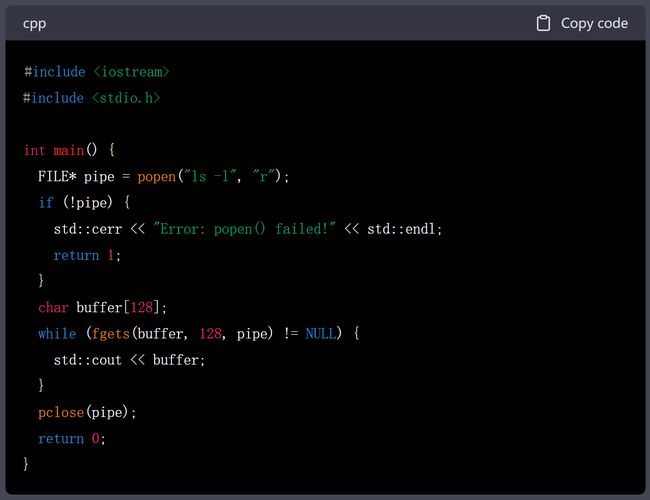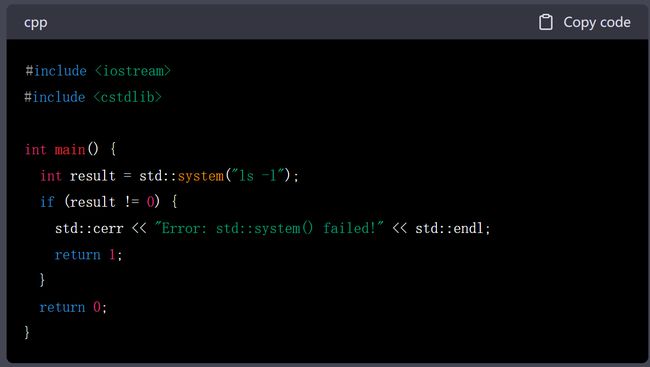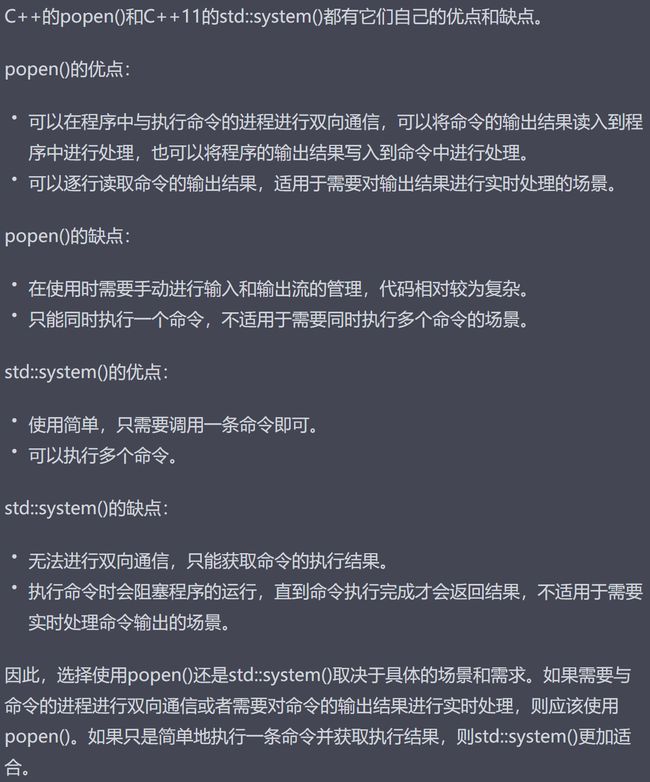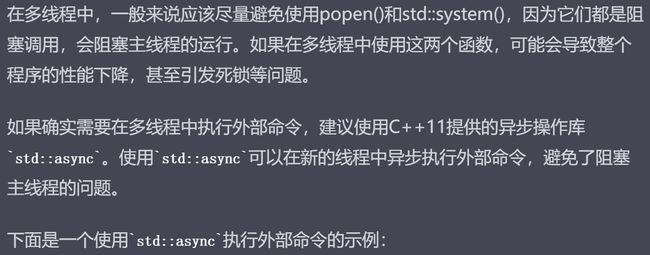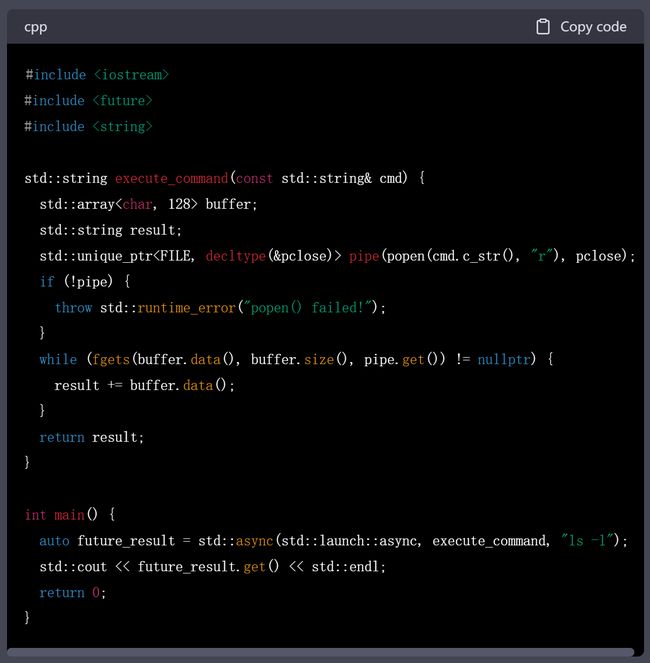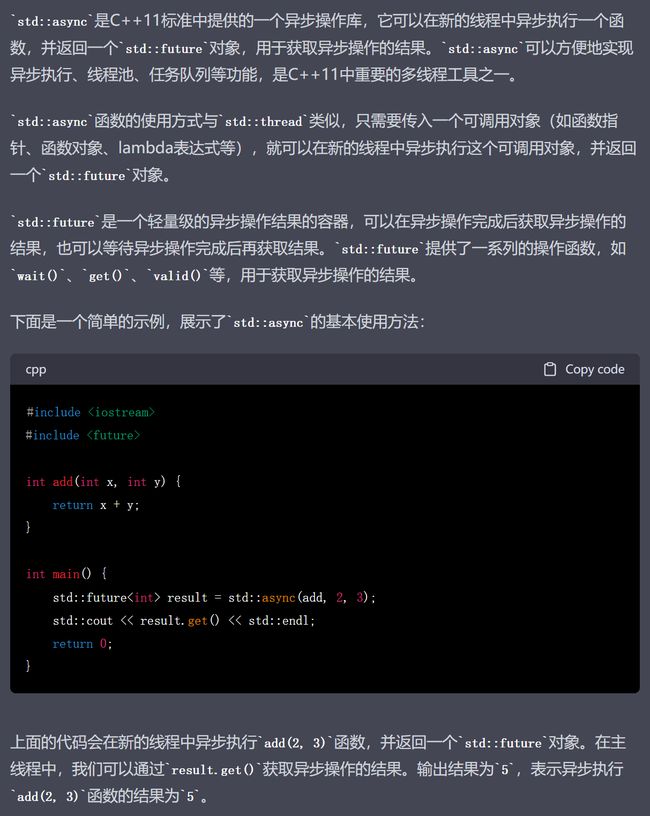C++笔记之popen()和std_system()和std_async()执行系统命令比较
C++笔记之popen()和std_system()和std_async()执行系统命令比较
code review!
文章目录
- C++笔记之popen()和std_system()和std_async()执行系统命令比较
-
- 1.popen()
- 2.std::system()
- 3.std::async()——C++11提供的异步操作库,适合在多线程中执行外部命令,建议使用!
-
- std::async和std::future
- 4.system()和std::async结合使用
- 5.popen()和std::async结合使用
1.popen()
代码
#include 2.std::system()
代码
#include 3.std::async()——C++11提供的异步操作库,适合在多线程中执行外部命令,建议使用!
代码
#include 上面的代码会在新的线程中异步执行"ls -l"命令,并将输出结果存储在一个字符串中。通过std::async和std::future的组合,可以轻松地在多线程环境中执行外部命令,避免了阻塞主线程的问题。
std::async和std::future
4.system()和std::async结合使用
void Node::clicked_a_button(int var) {
auto fut1 = std::async(std::launch::async, []() {
system("/home/user/xxx.sh arg1 arg2");
// or
// system("rm -r *.txt");
});
fut1.wait();
}
这段代码是一个C++函数,涉及到多线程编程和系统调用。让我们逐行分析:
-
void Node::clicked_a_button(int var)是一个成员函数,可能属于一个类(Node),接受一个整数参数var。 -
auto fut1 = std::async(std::launch::async, []() { ... });创建了一个异步任务(使用std::async)并将其分配给名为fut1的std::future对象。这个异步任务使用std::launch::async策略,表示它应该在一个新的线程中异步执行。 -
system("/home/user/xxx.sh arg1 arg2");这是一个系统调用,用于执行外部的shell脚本(xxx.sh)并传递两个参数(arg1和arg2)。这个命令将在一个新的子进程中运行,通常用于执行外部命令。 -
fut1.wait();这一行等待异步任务(在fut1中)的完成。这会导致主线程阻塞,直到异步任务执行完毕。
需要注意的是,虽然std::async用于启动异步任务,但在此代码中,主线程仍然会等待异步任务完成,因为在 fut1.wait(); 处进行了显式等待。这意味着异步任务的效果仅在执行系统调用期间是异步的,而在 fut1.wait(); 处,主线程将被阻塞,直到系统调用完成。
这种用法可以用于在C++中启动外部进程或shell脚本,但需要小心,因为system函数在执行时会阻塞主线程,可能导致整个应用程序在执行外部命令时暂停。如果需要更多的并发性,可以考虑使用std::thread或其他多线程库来在后台执行系统调用,以便主线程可以继续执行其他任务。
5.popen()和std::async结合使用
- 1.执行外部shell脚本并传递参数的简单例程
在C++中,您可以使用popen函数来执行外部Shell脚本,并使用std::async来异步执行它。下面是一个简单的例程,演示如何结合使用这两个功能来执行外部Shell脚本并传递参数。
#include 在上面的示例中,executeShellScript 函数接受Shell脚本的路径和要传递给脚本的参数。它使用 popen 执行脚本,并在异步任务中调用它。在 main 函数中,std::async 用于启动异步任务执行外部脚本。您可以在启动异步任务后执行其他任务,然后使用 result.get() 来等待异步任务的完成并获取返回的退出码。
请替换 "your_script.sh" 和 "your_argument" 为实际的脚本路径和参数。确保您的脚本在执行时可以接受参数并处理它们。
- 2.执行linux系统命令的简单例程
在C++中,您可以结合使用popen函数和std::async来执行Linux系统命令。下面是一个简单的例程,演示如何执行Linux系统命令并获取其输出。
#include 在上面的示例中,executeLinuxCommand 函数接受要执行的Linux命令,并使用 popen 执行该命令。然后,通过 std::async 在异步任务中调用它。在 main 函数中,std::async 用于启动异步任务执行Linux命令。您可以在启动异步任务后执行其他任务,然后使用 result.get() 来等待异步任务的完成并获取命令的输出。
请替换"ls -l"为您要执行的实际Linux命令。这个示例只是一个演示,您可以根据需要替换命令。确保您的Linux命令能够在Shell中正常执行。
